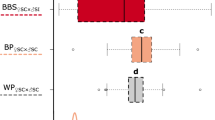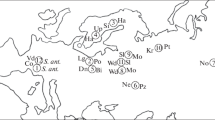Abstract
Mating experiments between monosporidial lines ofSorosporium consanguineum from Mexico and the Pacific Northwest indicate that incompatibility in theAristida smut is controlled by multiple alleles at one locus. Alleles a1 a2 were demonstrated in a collection from Chihuahua, Mexico onAristida ternipes. It is hypothesized that these alleles also control incompatibility in collections of the smut from western United States. Alleles a1 a3 were detected in a collection from Durango Mexico onAristida divaricata. Apparently, this is the first time multiple alleles have been shown to control heterothallism inS. consanguineum.
Similar content being viewed by others
References
Bauch, R. (1923) ÜberUstilago longissima und ihre Varietat Macrospora.Z. f. Bot. 15:241–279.
Bauch, R. (1934) Über Kreuzungen zwischen bipolar und multipolar sexuellen Brandpilzarten.Z. f. induktive Abstammungs- und Vererbungslehre 67:242–245.
Duran, R. (1965) Teliospore germination and genetic factors controlling compatibility inUstilago hilariicola.Mycologia 57:628–633.
Duran, R. (1968) Teliospore germination and compatibility factors inSorosporium texanum.Mycopath. et Mycol. Appl. 36:209–213.
Duran, R. (1969) Incompatibility inSorosporium consanguineum from western United States.Phytopathology 59:1638–1640.
Duran, R. (1970) Host and distribution records of some Mexican smut fungi.Mycologia 62: (Nov.-Dec. issue) In press.
Halisky, P. M. (1965) Physiologic specialization and genetics of the smut fungi III.Bot. Rev. 31:114–150.
Hoffmann, J. A. &Kendrick, E. L. (1969) Genetic control of compatibility inTilletia controversa.Phytopathology 59:79–83.
Whitehouse, H. L. K. (1951) A survey of heterothallism in the Ustilaginales.Trans. Brit. Myc. Soc. 34:340–355.
Whitehouse, H. L. K. (1954) Incompatibility in fungi. Proc. Eighth International Botanical Congress:151–160.
Author information
Authors and Affiliations
Additional information
Scientific Paper No. 3541. Washington Agricultural Experiment Stations, Pullman, Project 1729.
Rights and permissions
About this article
Cite this article
Duran, R. Evidence of multiple allelomorphy at the incompatibility locus in Sorosporium consanguineum. Mycopathologia et Mycologia Applicata 44, 89–94 (1971). https://doi.org/10.1007/BF02051875
Accepted:
Issue Date:
DOI: https://doi.org/10.1007/BF02051875




